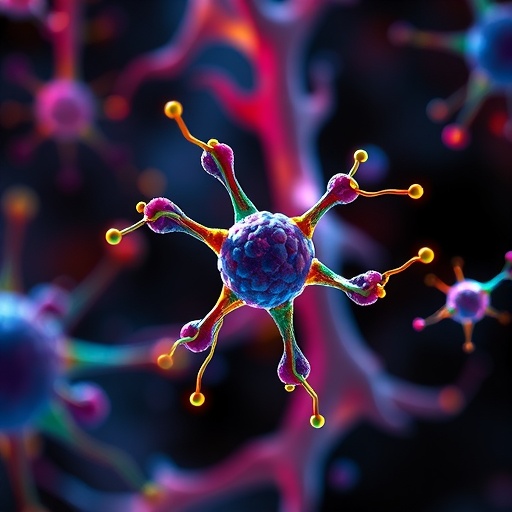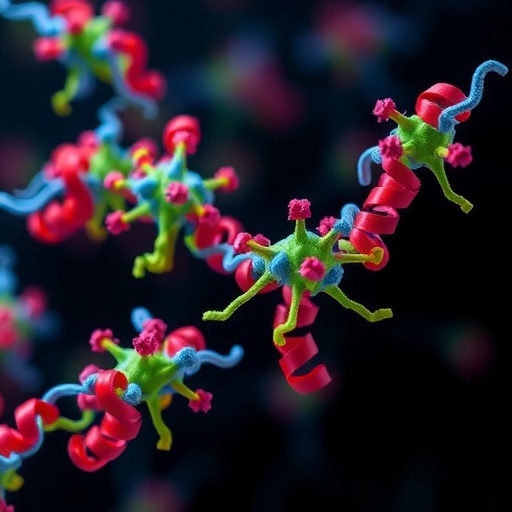
In a groundbreaking study poised to redefine therapeutic strategies for colorectal cancer, researchers have identified a novel molecular axis that not only suppresses tumor progression but also significantly enhances the efficacy of immune checkpoint blockade therapy. Central to this discovery is the DNMBP-AS1/hsa-miR-30a-5p/PGC1α regulatory pathway, which intervenes in cancer metabolism and immune response, offering a promising avenue to overcome existing treatment resistance.
Colorectal cancer remains one of the leading causes of cancer-related mortality worldwide, largely due to its complex tumor biology and the frequent development of resistance to conventional therapies. A critical hallmark of cancer cells is their metabolic reprogramming, known as the Warburg effect, where tumor cells preferentially utilize glycolysis for energy production, even in the presence of oxygen. This altered metabolic state supports rapid proliferation and survival, and targeting the underlying mechanisms of this effect has emerged as a potential strategy to curb tumor growth.
At the heart of this metabolic shift is the enzyme pyruvate kinase M2 (PKM2), a pivotal regulator of glycolysis in cancer cells. The study delineates how the DNMBP-AS1 long non-coding RNA, hsa-miR-30a-5p microRNA, and the transcriptional coactivator PGC1α coordinate to disrupt PKM2 activity, thereby counteracting the Warburg effect. DNMBP-AS1 acts as a molecular sponge for hsa-miR-30a-5p, preventing it from downregulating PGC1α expression. Elevated levels of PGC1α subsequently inhibit PKM2-mediated glycolysis, shifting the cancer cells away from the Warburg metabolic phenotype.
.adsslot_XIhoBq2G7x{width:728px !important;height:90px !important;}
@media(max-width:1199px){ .adsslot_XIhoBq2G7x{width:468px !important;height:60px !important;}
}
@media(max-width:767px){ .adsslot_XIhoBq2G7x{width:320px !important;height:50px !important;}
}
ADVERTISEMENT
This intricate regulatory cascade culminates in suppressed tumor proliferation and invasiveness, as cancer cells are forced to revert to less anabolic metabolic pathways that are less conducive to rapid growth. The impairing of PKM2 functionality not only limits energy production but also attenuates the biosynthetic processes necessary for tumor development. This metabolic intervention highlights the therapeutic potential of targeting non-coding RNA-mediated pathways in cancer.
Moreover, the study bridges metabolism and immunotherapy by investigating how the manipulation of the DNMBP-AS1/hsa-miR-30a-5p/PGC1α axis influences the tumor microenvironment, especially in the context of anti-PD-1 therapy. Immune checkpoint inhibitors such as anti-PD-1 antibodies have revolutionized cancer treatment by reinvigorating exhausted T cells, yet a substantial subset of colorectal cancer patients exhibits poor response due to various immunosuppressive mechanisms within tumors.
The suppression of PKM2-driven glycolysis not only hampers tumor growth but also reshapes the immune landscape. The research demonstrates that tumors with diminished Warburg effect exhibit reduced levels of immunosuppressive metabolites and enhanced infiltration of effector T cells. This metabolic reprogramming removes barriers to tumor immune recognition and destruction, thereby potentiating the efficacy of PD-1 blockade.
Through in vivo and in vitro experiments, the authors provide compelling evidence that restoring the DNMBP-AS1/hsa-miR-30a-5p/PGC1α axis improves therapeutic outcomes. Mouse models bearing colorectal tumors treated with immune checkpoint inhibitors displayed significantly delayed tumor progression and prolonged survival when this axis was activated. These findings not only underscore the metabolic-immune interface but also establish a novel combinatorial strategy that may overcome intrinsic and acquired resistance to immunotherapy.
On a molecular level, the study meticulously characterizes the interactions between non-coding RNAs and mitochondrial regulators, revealing an unexpected depth of crosstalk that extends beyond conventional gene expression controls. The ability of DNMBP-AS1 to modulate microRNA availability and thus indirectly influence mitochondrial biogenesis and function is particularly striking. PGC1α is known to control oxidative phosphorylation and mitochondrial dynamics, indicating that its upregulation may restore energetic balance disrupted by cancer metabolism.
The implications extend to potential biomarkers for patient stratification as well. Levels of DNMBP-AS1 and hsa-miR-30a-5p in tumor biopsies could predict responsiveness to metabolic interventions and immunotherapies, guiding personalized medicine approaches. The prognostic value of these molecules represents a critical step toward integrating metabolism-focused diagnostics into clinical oncology.
Furthermore, the study emphasizes the therapeutic feasibility of modulating non-coding RNAs using delivery platforms such as nanoparticles or antisense oligonucleotides. By targeting DNMBP-AS1 or hsa-miR-30a-5p directly, it may be possible to pharmacologically mimic the effect of genetic modification, broadening the clinical applicability of these findings. Such interventions could be synergistically combined with checkpoint inhibitors to maximize anti-tumor immunity.
This research also raises fascinating questions about the interplay between cancer cell metabolism and immune evasion. It suggests that metabolic enzymes like PKM2 not only fuel tumor growth but actively shape the immune microenvironment by influencing metabolite production and immune cell function. Dissecting these complex pathways offers fertile ground for discovering novel targets capable of reprogramming both cancer metabolism and immune surveillance.
The translational potential extends beyond colorectal cancer as well. The Warburg effect and immune checkpoint mechanisms are prevalent across many tumor types, implying broader relevance of the DNMBP-AS1/hsa-miR-30a-5p/PGC1α axis. Future studies may reveal whether similar molecular interactions operate in other cancers, enabling the development of cross-tumor therapies addressing metabolism-immunity crosstalk.
In addition to technical innovation, the study represents a successful integration of multi-omics approaches, combining transcriptomics, metabolomics, and immunophenotyping to provide comprehensive mechanistic insights. This systems-level understanding is essential in the age of precision oncology, where unraveling complex networks informs rational drug design and combination regimens.
Researchers also explore the downstream signaling pathways affected by PGC1α modulation, noting altered activity in hypoxia-inducible factors and AMP-activated protein kinase pathways, which are known to regulate cellular responses to metabolic stress. These findings suggest that the DNMBP-AS1 axis indirectly influences key metabolic sensors, further reinforcing its centrality in tumor biology.
The study concludes by outlining challenges ahead, including optimizing delivery methods for non-coding RNA therapeutics, understanding potential off-target effects, and conducting clinical trials to validate preclinical results. Nevertheless, the discovery represents an exciting milestone, illuminating new biological frontiers and therapeutic possibilities.
In summary, the identification of the DNMBP-AS1/hsa-miR-30a-5p/PGC1α axis as a regulator of the Warburg effect and immune checkpoint efficacy in colorectal cancer opens transformative prospects. By simultaneously curbing tumor metabolism and enhancing anti-tumor immunity, this molecular circuit offers a powerful strategy against one of the most stubborn forms of cancer. As research progresses, its integration into clinical practice could herald a new era of combinatorial cancer therapy rooted in metabolic and immunological synergy.
Subject of Research: The role of the DNMBP-AS1/hsa-miR-30a-5p/PGC1α axis in suppressing tumor progression in colorectal cancer by inhibiting PKM2-mediated Warburg effect and enhancing the efficacy of anti-PD-1 therapy.
Article Title: DNMBP-AS1/hsa-miR-30a-5p/PGC1α axis suppresses tumor progression of colorectal cancer by inhibiting PKM2-mediated Warburg effect and enhance anti-PD-1 therapy efficacy.
Article References: Wang, T., Zhang, W., Liu, J. et al. DNMBP-AS1/hsa-miR-30a-5p/PGC1α axis suppresses tumor progression of colorectal cancer by inhibiting PKM2-mediated Warburg effect and enhance anti-PD-1 therapy efficacy. Cell Death Discov. 11, 299 (2025). https://doi.org/10.1038/s41420-025-02561-2
Image Credits: AI Generated
DOI: https://doi.org/10.1038/s41420-025-02561-2
Tags: cancer metabolism regulationcolorectal cancer immunotherapyDNMBP-AS1immune checkpoint blockadelong non-coding RNA in cancermetabolic reprogramming in tumorsmicroRNA therapeutic targetsnovel cancer therapeutic strategiesPKM2 enzyme functiontreatment resistance in colorectal cancertumor progression suppressionWarburg effect in cancer





